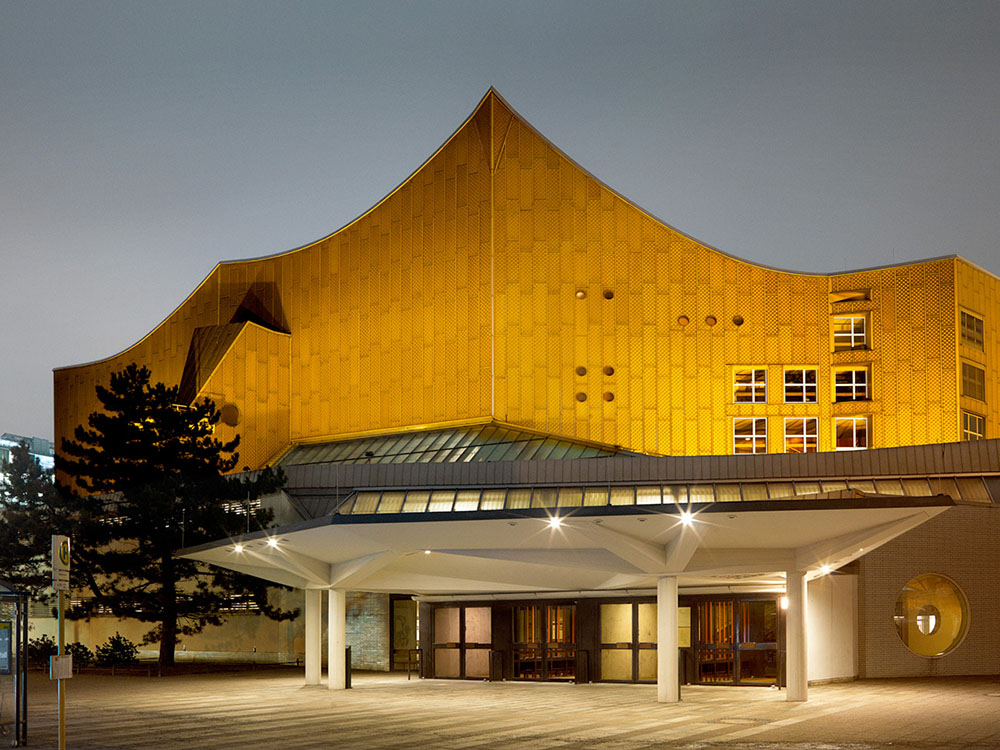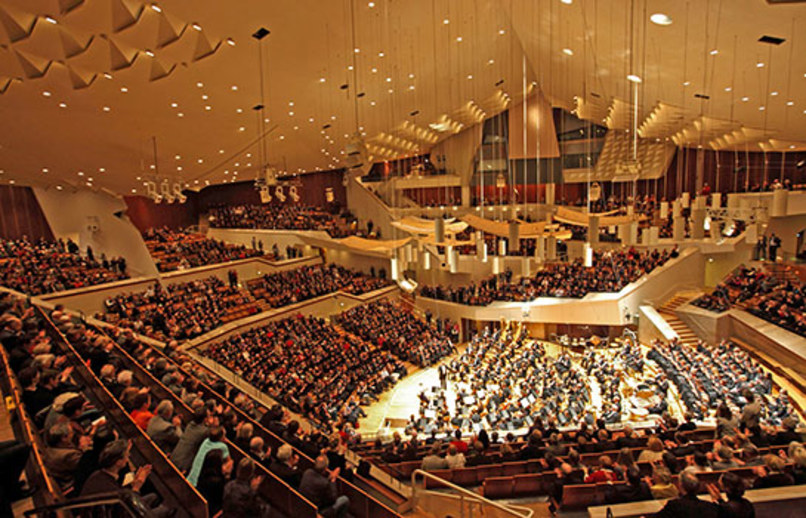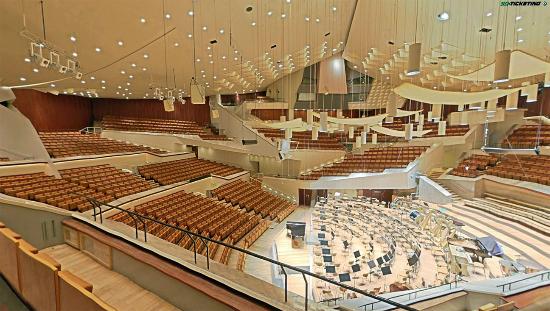The Berlin Philharmonic (German: Berliner Philharmoniker), is an orchestra based in Berlin, Germany and is consistently ranked as one of the best orchestras in the world.
Formerly Berliner Philharmonisches Orchester; BPO, its primary concert venue is the Philharmonie, located in the Kulturforum area of the city. Since 2002, its principal conductor is Sir Simon Rattle. Funding for the organization is subsidized by the city of Berlin and a partnership with Deutsche Bank.
In 2006, ten European media outlets voted the Berlin Philharmonic number three on a list of "top ten European Orchestras", after the Vienna Philharmonic and the Royal Concertgebouw Orchestra, while in 2008 it was voted the world's number two orchestra in a survey among leading international music critics organized by the British magazine Gramophone (behind the Concertgebouw). The BPO supports several chamber music ensembles.
History
The Berlin Philharmonic was founded in Berlin in 1882 by 54 musicians under the name Frühere Bilsesche Kapelle (literally, "Former Bilse's Band"); the group broke away from their previous conductor Benjamin Bilse after he announced his intention of taking the band on a fourth-class train to Warsaw for a concert. The orchestra was renamed and reorganized under the financial management of Hermann Wolff in 1882. Their new conductor was Ludwig von Brenner; in 1887 Hans von Bülow, one of the most esteemed conductors in the world, took over the post. This helped to establish the orchestra's international reputation, and guests Hans Richter, Felix von Weingartner, Richard Strauss, Gustav Mahler, Johannes Brahms and Edvard Grieg conducted the orchestra over the next few years. Programmes of this period show that the orchestra possessed only 46 strings, much less than the Wagnerian ideal of 64.
In 1895, Arthur Nikisch became chief conductor, and was succeeded in 1923 by Wilhelm Furtwängler. Despite several changes in leadership, the orchestra continued to perform throughout World War II. After Furtwängler fled to Switzerland in 1945, Leo Borchard became chief conductor. This arrangement lasted only a few months, as Borchard was accidentally shot and killed by the American forces occupying Berlin. Sergiu Celibidache then took over as chief conductor for seven years, from 1945 to 1952. Furtwängler returned in 1952 and conducted the orchestra until his death in 1954.
His successor was Herbert von Karajan, who led the orchestra from 1955 until his resignation in April 1989, only months before his death. Under him, the orchestra made a vast number of recordings and toured widely, growing and gaining fame. The orchestra hired its first female musician, violinist Madeleine Carruzzo, in 1982. When Karajan stepped down, the post was offered to Carlos Kleiber, but he declined.
In 1989, the orchestra elected Claudio Abbado as its next principal conductor. He expanded the orchestra's repertoire beyond the core classical and romantic works into more modern 20th-century works. Abbado stepped down from the chief conductorship of the orchestra in 2002. During the post-unification period, the orchestra encountered financial problems resulting from budgetary stress in the city of Berlin. In 2006, the Orchestra Academy of the Berlin Philharmonic established the Claudio Abbado Composition Prize in Abbado's honour.
In June 1999, the musicians elected Sir Simon Rattle as their next chief conductor. Rattle made it a condition of his signing with the Berlin Philharmonic that it be turned into a self-governing public foundation, with the power to make its own artistic and financial decisions. This required a change to state law, which was approved in 2001, allowing him to join the organization in 2002. Rattle's contract with the orchestra was initially through 2012. In April 2008, the BPO musicians voted in favour of retaining Rattle as their chief conductor through 2018. From 2006 to 2010, the general manager of the orchestra was Pamela Rosenberg. In September 2010, Martin Hoffmann became the orchestra's new Intendant.
In 2006, the orchestra announced it would investigate its role during the Nazi regime. In 2007, Misha Aster published The Reich's Orchestra, his study of the relationship of the Berlin Philharmonic to the rulers of the Third Reich. Also in 2007, the documentary film The Reichsorchester by Enrique Sánchez Lansch was released.
UNICEF appointed the Berlin Philharmonic Orchestra and Rattle as Goodwill Ambassadors in November 2007. On 10 January 2013, the orchestra announced the scheduled end of Rattle's tenure as artistic director and chief conductor in 2018. After a first abortive attempt on 11 May 2015 to choose a successor to Rattle, on June 22 2015, the orchestra announced its election of Kirill Petrenko as its next chief conductor. At the time of Petrenko's election, a starting date had not been announced for his tenure. In October 2015, the orchestra announced that Petrenko is formally to commence his contract as chief conductor in the 2019-2020 season, with scheduled guest appearances in the seasons prior to 2019-2020.
Concert halls
The orchestra's first concert hall, the Philharmonie situated on the Bernburger Straße in Berlin Kreuzberg, was inaugurated in 1882 in a building previously used as an ice rink and converted by the architect Franz Schwechten. In 1898, a smaller concert hall, the Beethovensaal on Köthener Straße, was also inaugurated for chamber music and chamber ensembles. The first Philharmonie was used until British bombers destroyed it on 30 January 1944, the anniversary of Hitler becoming chancellor. The orchestra played until the end of the war in the Staatsoper, Unter den Linden. The Staatsoper was also destroyed on 3 February 1945. In need of a venue, the Berlin Philharmonic played during the years following the war in the Titania-Palast, an old movie theater converted in a concert hall, and still used the Beethovensaal for smaller concerts. During the 1950s the orchestra moved its concerts at the Musikhochschule (today part of the Berlin University of the Arts), in the Joseph-Joachim-Konzertsaal. However, most of the recordings were done at the Jesus-Christus-Kirche in Berlin Dahlem, celebrated for its acoustics.
The need for a new Philharmonie was expressed since 1949, when the Gesellschaft der Freunde der Berliner Philharmonie e.V. (Friends of the Berliner Philharmonie Society) was created to gather funds. The building of the new Philharmonie started in 1961, following the design of architect Hans Scharoun, and it was inaugurated on 15 October 1963, with a performance of Beethoven's Ninth Symphony, conducted by Herbert von Karajan. Its location made it part of the Kulturforum, and the great hall (2,440 seats) was then complemented by a chamber-music hall, the Kammermusiksaal (1,180 seats), built in 1987, following the design of architect Edgar Wisniewski, after a project by Hans Scharoun.
The Berliner Philharmonie has since been the home of the Berlin Philharmonic, and its symbol. The orchestra's logo is based on the pentagon-shape of the concert hall.
On 20 May 2008, a fire broke out at the Philharmonie. One-quarter of the roof underwent considerable damage as firefighters cut openings to reach the flames beneath the roof. The hall interior also sustained water damage, but was otherwise "generally unharmed." The firefighters limited damage by the use of foam. The orchestra was restricted from use of the hall for concerts until June 2008.
On 18 December 2008, the orchestra announced the official creation of a Digital Concert Hall. This hitherto unique internet platform of the BPO enables persons with computer access all over the world to see and hear the Philharmonic's concerts, live or on demand, not only under recent conductors, but even previous concerts conducted, e.g., by Claudio Abbado. Since July 2014, the Digital Concert Hall additionally offers livestreams produced from HD movies of concerts by Herbert von Karajan in the 1960s and early 1970s.













